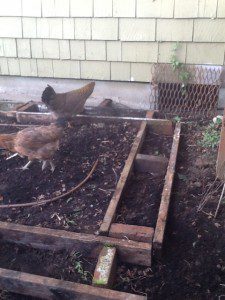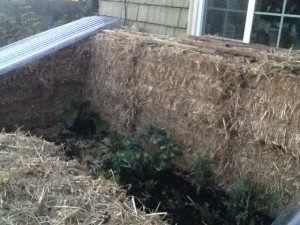This post below was written for us by our friend Scott Allison. As we all know, straw has multiple uses and this is a pretty easy/economical/functional use for bales. This is a quick a simple project that you can do to extend your growing season. The details below are for a simple, what I would call “annual” cold frame. In other words, this would need to be rebuilt each year because it is not plastered and protected from the elements. That said, it could be upgraded with ease to be a permanent structure if that’s what you are after. Here’s what Scott had to share:

The project took me just a few hours to complete and I was working by myself.

Second I placed the bales side by side. Two high on the north side and a single row on the south. Then I took apart a single bale and stepped the sides down, filling in where I needed to.

I planted a few broccoli, arugula, lettuce, collard greens, and chives and they all seem really happy. The night that I built the cold frame turned out to be the second frost in our area; however, the temperature inside the cold frame stayed well above freezing. The broccoli is now blooming so I think it’s gonna work pretty well. I intend to place some red brick towers in the north side corners as thermal mass and I imagine a few candles (in coffee cans of course) might go a long way to make for a really warm place to grow food during the winter.
I hope you enjoy the concept and creation,
Sustainably yours,
Scott Allison
GaianlogicConsulting.blogspot.com
503.886.9731



8 Responses
I have used whole straw bales in the garden for the last 3 years. I haven’t used them for a cold frame, but thought hey, why not? I am curious as to why you put the bales on a wood foundation if it’s not intended to be a permanent installation though. I have put straw bales into a square configuration, butting one end of a bale to the side of another, that leaves a hole inside of the configuration that I use as a receptacle for my kitchen waste composting. I put commercial steer and chicken manure on the top of the bales, soak it well, and planted my cole crops right on the bale. They have survived the week of nightly freezes just fine here in California recently without the greenhouse topper. I find that the straw bales stay intact for more than a year being laid directly on the ground. Last year, I had a really nice crop of melons and pumpkins sprawling from my straw bales at my old house. The previous year, I grew strawberry plants with mixed results, more likely because the drip emmitters I was using wasn’t cutting it for irrigation. I found that hand watering worked better. The interface between the straw and the soil became teeming with life, and was able to scrach a lot of the decomposed straw into the soil and had a bunch of nice fluffy mulch with the remainder of the bale after about a year and a half of growing stuff right on top of the bales.
Great stuff! I agree about the frame and the longevity. It seems that one could go with a year (or two) application for ease or go for the permanent set up. Bales really are amazing for insulting, eh!?
We used bales for our very first cold frame and found that it was very rotted by spring, and full of mice and slugs. Our next cold frame, the following winter was made of pine boards, and has been in use for seven years. We’re in the Northeast, and winters can be brutal. The wood works fine, we use double-glass windows. Never again with the bales- attracting slugs is not a good idea.
Interesting. I wonder if the climate was the main impact of the failure. Of course, as I said in the intro, I would consider building it under more permanent techniques, including plaster. That would stop the issues you had. I’m curious as to whether other folks have had similar issues with attempted “rough bale” cold frames and if the climates are similar in those that work versus those that fail.
Great idea! I was just looking around for a simple method to build a cold frame…this is the way for me, simple and elegant!
Hey there it’s fun to see the responses. I hope to keep an eye on them so as to answer spiny questions about the design and idea.
1. Why STRAWBALE ? The woman farmer has 12 rabbits and 15 chickens and so straw is used up quite regularly and so I saw this as a chance to reuse all the materials several times over.
2. The unlaying boards were to lift up the bails to avoid wicking moisture from the ground so the bails might have a longer life.
3. I purposely oversized the roof so as to keep the moisture off the bales. In this design the roof can be simply taken off piece by piece and replaced after work in the garden is done.
By covering the bales with plastic or garbags to protect from rain and sprinler water the bales will last for years.
I love the idea of straw bale building for buildings other than just houses. We’d like to build a small barn out of strawbales too, and then maybe a half-sunk greenhouse on a hill (something like the cold-frame).